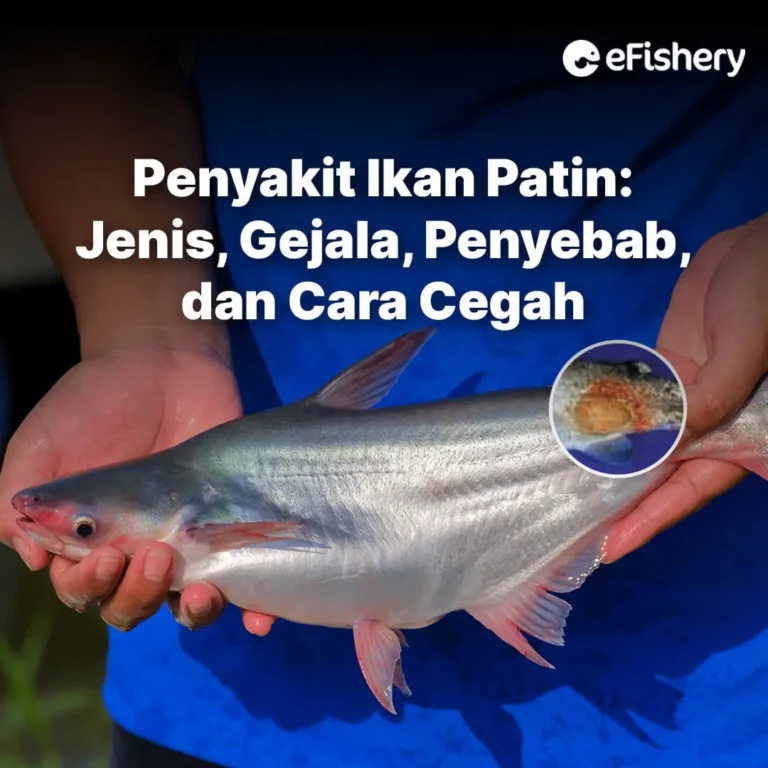Catfish is a fish commodity with a high consumption power in Indonesia. Cultivating catfish will definitely bring a sizable profit.
Quoted from Marine and Fisheries Ministry, the Indonesian catfish industry has succeeded in seizing the global market. The opportunity for local catfish to dominate the international market has opened wide.
However, when cultivating catfish, disease outbreaks must also be considered because it can disrupt the cultivation process. Not only that, catfish that experience health problems will experience changes in behavior. Starting from decreased buoyancy, slow movement, and decreased appetite.
If you see some of these signs, you should be aware of diseases that are prone to attack catfish. You need to carry out routine monitoring and early prevention so that catfish are not susceptible to disease.
Causes of Disease in Catfish
Catfish disease is caused by parasites or pond condition factors that are not suitable. In addition to this, the appearance of the disease is influenced by the weak condition of the fish. You need to know what causes catfish to get sick in order to minimize disease attacks.
Sources of diseases that attack fish can be due to bacterial, fungal, parasitic infections, and several other diseases such as injuries, tumors or abnormalities, constipation, and congenital diseases. Parasitic infection is the scariest disease because it is easily transmitted.
Therefore, you need to know what are the causes that make catfish sick. The goal is to prevent disease from arising due to the source of the disease above.
1. Parasite Attack
The main problem in cultivating catfish is the emergence of parasitic diseases. Parasite attacks can cause a decrease in the quality of aquaculture, starting from reducing the productivity of catfish to causing economic losses for farmers.
2. Polluted Environment
A polluted environment (ammonia which becomes poison) will cause burns to fish tissue, including injuries to the gills. Then, the fish will show symptoms of poisoning. Fish exposed to ammonia will usually make irregular stomping movements and exhibit lethargic or stagnant behavior underwater.
3. Water Quality is Decreasing
An environment with large fluctuations in temperature, pH, salinity and turbidity will cause stress and reduce fish appetite. As a result, the level of diseased catfish is high and your yields are not optimal.
4. Inappropriate Feed
Feed that is not in accordance with the needs of fish will make fish not grow properly, even susceptible to disease. Good quality feed will help create the body's immune system in fish.
5. Injured Fish Body
The body of the injured catfish will be slimy or ooze pus. This is usually caused by an infection accompanied by various other diseases.
6. Genetic Factors
Weak fish body condition due to genetic factors (not strong enough to face environmental changes) will cause abnormalities. One of the causes is the marriage of one offspring (inbreeding).
Types of Diseases of Catfish
Diseases in catfish are generally caused by pathogens. Diseases caused by pathogens (fungi, bacteria, and viruses) are quite communicable diseases, the cause of infection is poor quality feed and decreased water quality.
Excessive and poor quality feed will result in catfish suffering from digestive diseases, while decreasing water quality can make it difficult for fish to breathe.
You need to know the type of catfish disease and its symptoms. That way, it will be easier for you to prevent or handle it.
Here are some diseases that often occur in catfish:
1. White Spots
White Spots is a disease of white spots on the body of fish due to infection Ichthyophthirius multifiliis. The main cause of this disease is protozoa that live because the pool water is too cold.
In addition, the large amount of rainwater mixed in the pond also causes the growth of these protozoa. As a result of this disease, the percentage of deaths reached 100% in just a few days.
Symptom:
- The presence of white spots on the mucous layer of the skin, fins and gills.
- Fish often congregate in dark places.
- Often rubbed his body on the pool wall.
- Decreased appetite
2. Aeromonas
This disease is a disease that often attacks catfish. PAeromonas disease can cause death of up to 80%, in a short period of time (1–2 weeks) so it is very detrimental to fish farmers. The cause of this disease is Bacteria Aeromonas sp..
This disease arises due to stress conditions due to high fish density, poor quality feed, handling rough fish, and poor water quality. Sometimes, catfish that are attacked by Aeromonas disease are more often alone and swim on the surface of the water.
Symptom:
- The appearance of red spots in almost all parts of the fish's body (belly, chest, fins, to the tail).
- There are wounds or ulcers.
- The mucus fluid in the fish's body is reduced so that when touched the fish feels rough.
- Bleeding occurs.
3. MES
MES disease or Motile Edwardsiella Septicemia is a disease caused by bacteria Edwardsiella tarda. Infection from this bacteria causes a decrease in the productivity of catfish cultivation, causing losses for farmers. Transmission of this bacterial infection occurs through contact between one host and another through the culture water medium.
Symptom:
- Catfish become lazy to swim.
- Fish have no appetite.
- The wound on the skin will then extend to the flesh, if not treated immediately, the wound will become an ulcer and ooze pus.
- Bleeding occurs.
4. Trichodiniasis
This itchy disease in fish attacks newly hatched fish fry, up to 1 month old fish. This disease attacks the skin, fins and gills. The cause is a parasitic infection Trichodina sp.. As a result of this disease, many fish have died. The percentage of deaths can reach 50%.
Symptom:
- Pale body color.
- Discolored scales, peeling scales, lesions on the skin.
- Production mucus excessive.
- The fish looks thin.
- Fish feel itchy and often rub their bodies on objects around them.
- Fish often jump in the pond.
- Gill damage.
How to Prevent Catfish Disease
Preventing catfish disease is better than treating it. If catfish disease has attacked, of course the losses incurred will be greater. You need to complete your knowledge on how to prevent catfish disease. That way, your process of cultivating catfish will be safe from diseases that attack.
Here's how to deal with sick catfish that you can do:
1. Controlling Water Quality so that it is Always Optimal
You need to provide optimal environmental conditions for catfish, by controlling water quality. Water quality affects the growth, health level, and survival of catfish. Water quality must be maintained because water can become very dangerous if routine control is not carried out.
Poor water quality can cause:
- Fish experience stress and decreased immunity.
- Pathogens are easy to grow.
- Potential for disease.
2. Good Biosecurity Implementation
Implement a good biosecurity system or fish quarantine. By doing biosecurity, fish will avoid disease. The following are the benefits of implementing biosecurity for catfish:
- Reducing the risk of disease.
- Early detection of fish disease outbreaks.
- Reduce losses in the event of a disease outbreak.
- Efficiency of time, feed, and energy.
- The quality of the fish is more guaranteed.
3. Provision of Quality Feed and Supplements
Provide feed and supplements according to the dosage and needs of catfish. You are advised to be able to calculate feed requirements so that at the maintenance stage you can minimize disease.
4. Benur with SPF
Make sure you choose quality catfish seeds and are free from disease or viruses.
5. Administration of Routine Probiotics
The way to support fish health is to provide probiotics regularly. Giving probiotics can increase the immune system of fish. The following are the criteria for selecting probiotics for catfish:
- Improve the catfish immune system.
- Minimize disease.
- Contains complete multivitamins.
- Being the right combination to meet the nutritional needs of catfish feed.
- Made from organic materials that have a good impact on fish health.
6. Monitoring or Routine Sampling of Catfish
Sampling catfish is a procedure that is carried out when carrying out fish health monitoring activities. With routine sampling of catfish can minimize the transmission of fish diseases.
Cegah Penyakit Ikan Patin dengan eFeeder di Aplikasi eFisheryKu!

Seperti yang sudah dijelaskan di atas, salah satu penyebab ikan patin terserang penyakit adalah karena pemberian pakan berlebih. Pemberian pakan berlebihan akan berdampak buruk pada proses budidaya.
For regular feeding without any leftover feed being wasted and maintaining the quality of pond water, eFishery presenting eFeeders, alat pemberi pakan otomatis yang dapat menebar pakan secara praktis, efektif, dan merata ke seluruh kolam.
eFeeders bisa Bapak/Ibu beli dan sewa di aplikasi eFisheryKu, aplikasi budidaya ikan dari eFishery yang mempermudah proses budidaya ikan Bapak/Ibu dengan fiturnya yang sangat beragam.
Selain beli/sewa eFeeders, di eFisheryKu Bapak/Ibu bisa membeli pakan ikan dengan mudah, mendapatkan akses ke institusi finansial yang diawasi OJK, dan menjual ikan hasil panen.
Downloads eFisheryKu dan registrasi sekarang juga untuk dapat banyak keuntungan dengan klik tombol di bawah ini!
Questions Regarding Catfish Disease
Fungal diseases usually occur due to poor water conditions that cause injuries to the fish's body.
Catfish die easily due to dirty pond water conditions and high ammonia which causes bacterial infections in catfish. If not treated immediately, the catfish will die.
Catfish experience stress due to environmental factors that are not suitable. If the pond water is dirty, the stocking density is high, and the feed is not of good quality, it will stress the catfish.
During the cultivation of catfish from seeds to harvestable, you need to change the water 2-3 times a week.
